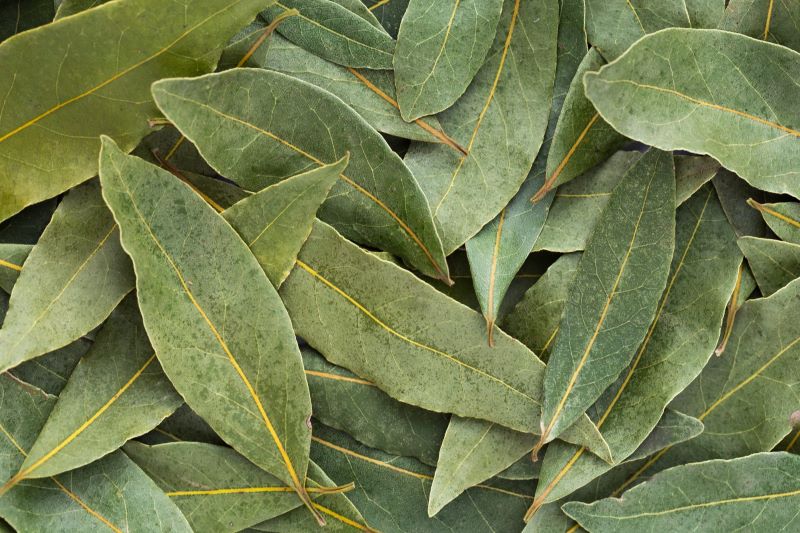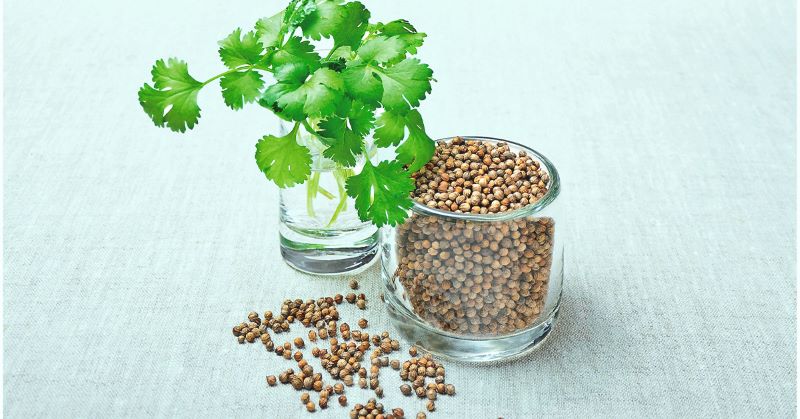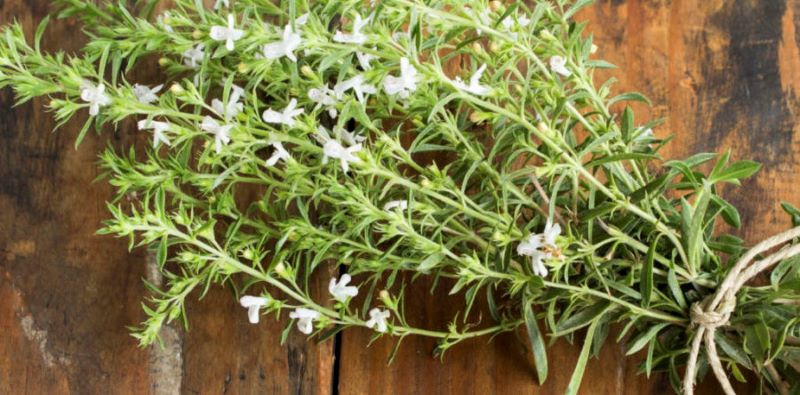What’s your substitute for rosemary? In cooking, it can be a herb that is filled with flavor as well as function. I love the flavor of rosemary, but sometimes you just don’t have it on hand. I’ve got some great ideas on a substitute for rosemary or two.
So You’re Interested in Rosemary?
Rosemary is a herb that grows as a perennial in zones 5 to 10. It is often used as a culinary herb, but it also has many health benefits. Rosemary can be grown indoors or outside, depending on the weather and sun exposure.
Rosemary is a woody perennial that can grow to a height of 2-3 feet tall. The shrub has green leaves that are narrow, pointed, and fragrant. It blooms in the summer months with small white flowers that grow in large clusters at the top of the plant.
Rosemary is related to mint, so it has similar properties — including antibacterial properties. This makes rosemary an excellent choice for use in homemade cleaning products, such as deodorizing sprays and disinfecting wipes made with vinegar and water.
The leaves are harvested throughout the growing season for culinary uses. Rosemary has a stronger flavor than other herbs like thyme or oregano, so it can be used sparingly when cooking soups and sauces or even roasted vegetables like potatoes and carrots!
You can also add rosemary essential oil to your diffuser to create a calming atmosphere in your home.
Dried Rosemary VS. Fresh Rosemary
If you are looking for a tasty herb to add to your dishes, rosemary is a great choice. It has a unique flavor that tastes great in soups, stews, and other dishes. However, rosemary comes in two different forms: dried and fresh. Choosing between the two can be difficult because they have very different qualities.
Dried Rosemary
If you are cooking with dried rosemary, it is important to know how long it will last before using it. Dried rosemary lasts longer than fresh rosemary because it does not contain any water content. As a result, it does not spoil as quickly as fresh rosemary does. Dried rosemary can last for up to three years if stored properly in an airtight container away from sunlight or moisture.
Fresh Rosemary
Fresh rosemary can be used immediately after purchasing it from the store or farmer’s market because there is no need to dry it first like with dried rosemary leaves (unless you want to). However, fresh rosemary is only good for about two weeks after purchase before it starts losing its flavor and aroma (the same goes for most herbs). This means that if you want to use fresh rosemary before it starts losing its quality, you must use it within a couple of weeks of purchasing.
Why Use substitutes for Rosemary?
Rosemary is a flavorful herb that is often used in cooking. It is also used to flavor savory dishes and desserts. Rosemary has been used for years as a medicinal herb, but it has recently become popular as an alternative treatment for cancer.
There are many reasons why you may want to use a substitute for rosemary instead of the actual herb itself:
1. Save money
Buying fresh herbs and spices can be expensive, especially if you have no idea how long they will last before spoiling! Substitutes are much cheaper than buying the actual herbs and spices themselves, especially since they keep longer than fresh varieties.
2. More convenient
If you don’t have access to fresh rosemary at all times of day or night (like during winter), then using a substitute may be more convenient for your lifestyle!
3. Easier storage
Fresh herbs have a very short shelf life, so they won’t last long if you don’t use them within a week’s time. This means you’ll have to use rosemary often or throw it out, which is a waste of money. Instead, spices can be used up over time.
The 11 Best Substitutes for Rosemary
Rosemary is a wonderful herb that can be used to flavor many dishes. If you don’t have any fresh rosemary on hand, there are lots of good substitutes available. Here are some ideas.
1. Basil
Like rosemary, basil has a strong, woodsy flavor that works well with beans, tomatoes, and many other foods. It’s also very easy to grow in a garden or container.
2. Bay Leaf

Bay leaves have a similar aroma as rosemary but they are less potent. You will need about 2 bay leaves for every 1 teaspoon of rosemary needed for your recipe so be careful not to use too much! Bay leaves are best added at the beginning of cooking so they have time to infuse their flavor into the dish before serving. Bay leaves also lose their potency over time so make sure they’re fresh before adding them to your dish.
3. Thyme
Thyme is another common herb that has a similar taste profile to rosemary. It’s often used in combination with other herbs like parsley or sage to add an extra layer of flavor to soups and stews. Thyme is also quite easy to grow in your garden or container.
4. Sage
Sage is another herb that works well as a substitute for rosemary. Both herbs have a woodsy flavor, but sage is milder than rosemary so you can use more without overpowering your dish.
5. Parsley
Parsley is a great substitute for rosemary because it has a similar flavor and appearance. The fresh herb can be used in the same way as rosemary, but its flavor is milder and less pungent. It also tends to have a more subtle aroma than rosemary, but both herbs can be easily found at any grocery store or market.
6. Coriander

Coriander is a good alternative to rosemary because it has similar flavors, but with a much lighter taste. Coriander leaves are round, flat, and green in color, while the seeds are darker yellow-orange in color. This herb can be added to dishes like chicken or fish to give them extra flavor without overpowering the dish. If you don’t have any fresh coriander on hand you can use dried coriander seeds instead!
7. Dill
Dill is an herb commonly used in Scandinavian countries as well as Eastern Europe. It has a strong flavor that pairs well with fish dishes such as salmon burgers or smoked salmon salads.
8. Marjoram
Marjoram is a great substitute for rosemary. It’s a fragrant herb that has a similar flavor profile to rosemary but with a hint of oregano and basil. Marjoram is used in dishes like soups, stews, salads, and egg dishes. I even use it on my grilled cheeses!
9. Savory (Satureja hortensis)

This perennial herb comes in several varieties, including winter savory (Satureja montana) and summer savory (Satureja hortensis). Its leaves have a similar flavor to rosemary’s, but they’re not as strong. You can use savory in place of rosemary in most recipes with good results.
10. Tarragon (Artemisia dracunculus)
Tarragon is another perennial herb that has a similar flavor to rosemary but isn’t quite as strong. It’s also easier to grow than rosemary because it doesn’t require much water or sunlight — just give it well-drained soil and plenty of room to spread out.
11. Oregano
It has more of a spicy taste than rosemary does, but they’re still similar enough that they can be used interchangeably in most dishes. You can use either one with tomatoes or casseroles because both oregano and rosemary have an affinity for tomato-based dishes.
FAQs
1. What are the alternative names for rosemary?
Rosemary is also known as Rosmarinus officinalis, which is derived from the Latin words Ros (dew) and Marinus (of the sea). It is also called common rosemary, garden rosemary, culinary rosemary and true rosemary.
2. How much does rosemary cost?
The cost of rosemary depends on where you buy it from and what size container you get. A small package of fresh rosemary will cost about $4 at most grocery stores or farmer’s markets, while a larger bag may cost up to $10 or more depending on its size. If you live near a farmer’s market, then chances are there will be plenty of vendors selling fresh plants at very reasonable prices!
3. How do I use rosemary?
You can use fresh or dried rosemary in recipes for soups, stews, meat and poultry dishes, and fish dishes. It’s especially delicious with potatoes and carrots — try roasting them together with olive oil and rosemary in the oven for a delicious side dish!
4. Is there anything I shouldn’t eat with rosemary?
Yes! Do not eat fresh rosemary if you have high blood pressure or heart disease, because it may increase your risk of bleeding during surgery or injury.
5. How do I store fresh herbs?
Fresh herbs should be stored in a cool place with good ventilation to prevent moisture loss since they contain high water content which makes them prone to spoilage easily if kept improperly after purchase or harvest time.
6. What does rosemary taste like?
Rosemary has a strong flavor that is reminiscent of pine needles and mints like spearmint or peppermint candy. It has an earthy smell similar to sage but stronger than most other herbs used in cooking or baking recipes.
In Summary
The following plants are good substitutes for rosemary, though you should be aware that the flavor of these herbs is not exactly the same as that of true rosemary.
